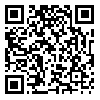BibTeX | RIS | EndNote | Medlars | ProCite | Reference Manager | RefWorks
Send citation to:
URL: http://rehabilitationj.uswr.ac.ir/article-1-1776-fa.html
URL: http://rehabilitationj.uswr.ac.ir/article-1-1776-fa.html
2- گروه سنجش و اندازهگیری، دانشکده روانشناسی و علوم تربیتی، دانشگاه علامه طباطبایی، تهران، ایران. ،
3- گروه روانشناسی تربیتی، دانشکده روانشناسی و علوم تربیتی، دانشگاه خوارزمی، تهران، ایران.
4- گروه روانشناسی و آموزش کودکان استثنایی، دانشکده روانشناسی و علوم تربیتی دانشگاه علامه طباطبایی، تهران، ایران.
هدف بر اساس ویرایش پنجم راهنمای تشخیصی و آماری اختلالات روانی، اختلال طیف اوتیسم، اختلالی عصبیرشدی است که با نقص مداوم در ارتباط اجتماعی و تعاملات اجتماعی دوجانبه و الگوها، علایق، رفتارها و فعالیتهای تکراری و محدود همراه است. به بیان دیگر، اختلال طیف اوتیسم شرایطی مادامالعمر است که با مشکلات فراگیر در روابط متقابل اجتماعی و ارتباطات، رفتارهای کلیشهای و علایق محدود مشخص میشود. تشخیص زودهنگام اختلال طیف اوتیسم میتواند به اجرای مداخله بهنگام و در نتیجه بهبود پیامدهای رشدی منجر شود. ابزارهای غربالگری والدین، ابزارهایی ایدهال برای شناسایی بهنگام اختلالات طیف اوتیسم است، زیرا این ابزارها اطلاعات تشخیصی را از افراد آشنا با کودک به دست میآورند و اجرا و نمرهگذاری آنها آسان است. بسیاری از آزمونهایی که برای غربالگری اوتیسم از سنین بالا استفاده میشوند، این اختلال را تشخیص میدهند، به همین دلیل هدف این مطالعه هنجاریابی آزمون غربالگری اختلالات طیف اوتیسم است که سعی میکند این اختلالات را در سنین کم (۱۲ تا ۴۸ ماهگی) غربالگری کند. این آزمون شامل ۳۶ سؤال است و به صورت بلی یا خیر به آنها پاسخ داده میشود.
روش بررسی جامعه پژوهش حاضر، همه کودکان با اختلالات عصبیرشدی و کودکان عادی شهر تهران است. ملاک انتخاب کودکان، داشتن سن کمتر از ۸ سال بود. در کودکان اوتیستیک، ملاکهای تشخیص عبارت بود از: نقصان مداوم ارتباط اجتماعی و تعاملات اجتماعی در موقعیت های مختلف و الگوهای رفتار و فعالیتهای تکراری محدود که متخصص و روانپزشک تشخیص اولیه دادند. در کودکان عادی نبود این مشکلات ملاک انتخاب بود. در این مطالعه توصیفی کودکان با اختلالات عصبیرشدی (اوتیستیک ۱۳۵ و کمتوان هوشی ۷۰ نفر) و کودکان عادی (۴۷ نفر برای تشخیص روایی افتراقی) شهر تهران به صورت هدفمند انتخاب شدند. از این تعداد ۹۷ نفر دختر و ۱۵۷ نفر دیگر پسر بودند. والدین شرکتکنندگان در این مطالعه در زمان حضور در کلینیکهای خدمات روانشناختی و بیمارستانهای شهر تهران (۲۵۲ نفر) به سؤالهای آزمون غربالگری در مدت ۱۰ دقیقه پاسخ دادند. متخصصان روایی آزمون را از طریق محتوایی و با روش افتراقی با تکنیک تحلیل واریانس که معناداری تفاوت بین سه گروه شرکتکنندگان را در نمره بهدستآمده از آزمون نشان میدهد و اعتبار از طریق ضریب همسانی درونی کودرریچاردسون ۲۰ را محاسبه کردند. همچنین برای تعیین نقطه برش از دو شاخص اعتبار (حساسیت و ویژگی) استفاده شد.تحلیل دادهها از طریق نرمافزار SPSS ویرایش ۲۱ انجام شد.
یافتهها روایی محتوایی آزمون با توجه به نظر متخصصان تأیید شد. نتایج بررسی روایی افتراقی نشان داد میانگین گروه عادی، گروه کمتوان هوشی و گروه اختلالات طیف اوتیسم به ترتیب از کمترین به بیشترین (P=۰/۰۰۱) است. اعتبار آزمون که از تکنیک کودرریچاردسون محاسبه شد برابر با ۰/۷۳ بود. ویژگیهای روانسنجی ابزارهای غربالگری والدین معمولاً از طریق دو شاخص حساسیت و ویژگی ارزیابی میشود. حساسیت به صحت غربال کودک با اختلال طیف اوتیسم اشاره دارد، در حالی که ویژگی به صحت غربال کودک بدون اختلال طیف اوتیسم اشاره میکند. نتایج پژوهش حاضر نشان داد آزمون غربالگری اختلالات فراگیر رشد، ویرایش دوم (PDDST-II) از نظر دو شاخص احساسات و ویژگی در وضعیت مطلوبی قرار دارد و میتواند کودکان با اختلال اوتیسم و کودکان بدون اختلال اوتیسم را بهدرستی شناسایی کند. دو شاخص حساسیت و ویژگی در نمره پنج به بیشترین حد خود رسیدند. به همین دلیل نقطه برش آزمون نمره پنج و بیشتر تعیین شد.
نتیجهگیری نتایج پژوهش حاضر نشان داد آزمون غربالگری اختلالات فراگیر رشد، ویرایش دوم (PDDST-II)، از نظر ویژگیهای روانسنجی وضعیت مطلوبی برای تمییز کودکان دارای اختلال طیف اوتیسم از دیگر اختلالات رشدی مانند کمتوانی هوشی و کودکان عادی دارد. همچنین این آزمون ضریب اعتبار مناسب و برای تشخیص کودکان با اختلال طیف اوتیسم روایی مناسبی دارد.
دریافت: 1394/4/27 | پذیرش: 1396/9/11 | انتشار: 1397/4/24
| بازنشر اطلاعات | |
 |
این مقاله تحت شرایط Creative Commons Attribution-NonCommercial 4.0 International License قابل بازنشر است. |







